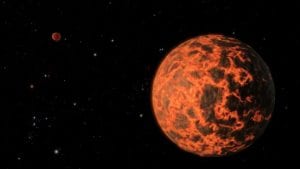UCF discovers exoplanet neighbor
The University of Central Florida has detected what could be its first planet, only two-thirds the size of Earth and located right around the corner, cosmically speaking, at a mere 33-light years away.
The exoplanet candidate called UCF 1.01, is close to its star, so close it goes around the star in 1.4 days. The planet’s surface likely reaches temperatures of more than 1,000 degrees Fahrenheit. The discoverers believe that it has no atmosphere, is only two-thirds the gravity of Earth and that its surface may be volcanic or molten.
“We have found strong evidence for a very small, very hot and very close-by planet with the help of the Spitzer Space Telescope,” said Kevin Stevenson, a recent Ph.D graduate from UCF and lead author of the paper, which appears online tomorrow in The Astrophysical Journal. “This discovery is a significant accomplishment for UCF.”
Stevenson and his colleagues were studying a hot-Neptune exoplanet, designated GJ 436b, already known to exist around the red-dwarf star GJ 436, when data revealed clues that led them to suspect there could be at least one new planet in that system, perhaps two.
Read what NASA wrote about this discovery here.
The team noticed slight dips in the amount of infrared light streaming from the star. A review of Spitzer archival data showed that the dips were periodic, suggesting that a planet might be blocking out a small fraction of light as it passed in front of GJ 436, as seen from Earth.
“I could see these faint dips in the starlight and I wanted to determine their source. I knew that if these signals were periodic, they could be from an unknown planet,” said Stevenson, who is now a postdoctoral scholar at the University of Chicago.
So he, UCF planetary sciences professor Joseph Harrington and UCF graduate student Nate Lust began looking at the data. They sifted through hundreds of hours of observations collected from Spitzer, the Deep Impact spacecraft, the ground-based Very Large Telescope in Chile and the Canada-France-Hawaii Telescope near the summit of Mauna Kea in Hawaii.
This transit technique, used by a number of telescopes, including NASA’s Kepler space telescope, relies on these tiny, partial eclipses to find exoplanet candidates. Spitzer has performed science work on known exoplanets before, but UCF-1.01 represents the first time Spitzer has made a transit discovery.
With the finding of UCF-1.01, GJ 436 is likely now home to the first multi-transiting-planet system described by a mission other than Kepler. Of the 1,800 stars identified by Kepler as candidates for having planetary systems, only three are verified to contain sub-Earth size exoplanets.
The depth and duration of a transit reveals basic properties of an exoplanet, such as its size and distance from a host star. In UCF-1.01′s case, its diameter is estimated at 5,200 miles, or two-thirds that of Earth, placing the world among the smallest on record. The team also noticed hints of yet another potential planet dubbed UCF-1.02, but its period was impossible to estimate.
So why aren’t scientists calling UCF-1.01 a planet?
A measured mass is needed to verify that these objects are planets, but even the most sensitive instruments currently available are unable to measure exoplanet masses this small.
“Despite the lack of a confirmed mass, the team is confident future observations will verify our findings,” Harrington said.
Spitzer scientists are eager to see what the future will bring.
“I hope future observations will confirm these exciting results, which show Spitzer may be able to discover exoplanets as small as Mars,” said Michael Werner, Spitzer Project Scientist at JPL. “Even after almost nine years in space, Spitzer’s observations continue to take us in new and important scientific directions.”
Others who contributed to the study include: Nikole Lewis (University of Arizona), Guillaume Montagnier (European Organisation for Astronomical Research in the Southern Hemisphere), Julianne Moses (Space Science Institute), Channon Visscher (Southwest Research Institute) and UCF students Jasmina Blecic, Ryan Hardy, Patricio Cubillos and Christopher Campo.
Stevenson earned his bachelor’s degree in physics from Simon Fraser University and a master’s degree in astronomy from the University of Western Ontario. In May 2012, he earned his Ph.D in physics (planetary sciences track) from UCF and earned the Order of Pegasus for his high academic and professional achievements as well as his service to the community. He has published articles in Nature and The Astrophysical Journal.
Harrington joined UCF in 2006 and is now an associate professor in the planetary sciences group. Previously he was at Cornell University for almost 10 years. He has multiple degrees from the Massachusetts Institute of Technology. Harrington’s research interests include planetary and exoplanetary atmospheres, comet impacts into atmospheres, astronomical data analysis methodology and infrared observing techniques.
Lust is a graduate student in the department of physics at UCF.

